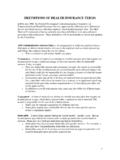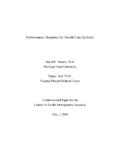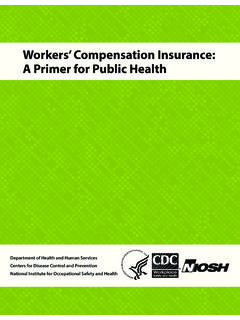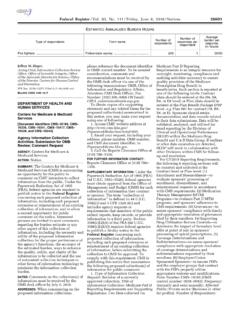Transcription of Other care Prescription drugs TRENDS Nursing …
1 PPOs continue to be the most popular plan type, enrolling 48% (combined) of covered employees are more likely to offer multiple plan it went: what was paid forAdministration and net costOther carePrescription drugsNursing home and home health carePhysician and clinical servicesHospital careNote: The total for insurance categories exceeds 100 percent because individuals can have multiple sources of coverageSource: Centers for Medicare & Medicaid Services, Office of the Actuary, National health Statistics Group (February 2017): IN health BENEFITS2018 National health Benefits Statistics & TRENDS Report103607 MUEENABS 10/17A COMPETITIVE JOB MARKETRISING health CARE COSTS: 2017#1 BENEFIT FOR EMPLOYEESAs an employer, you know better than anyone what your most valuable assets are: your people. And you know it s becoming harder than ever to hire the best people.
2 One simple reason is there are fewer candidates looking for work. In fact, unemployment dropped from a peak of 10% in October 2009 to just in August To compete for this shrinking talent pool, you have to pay employees more. Wages are slowly rising, and the cost of benefits continues to grow, too, with employers spending 3% more on health benefits in 2017 than in So how can you hire the best people? One way to attract employees is to offer a compensation package that matches or better yet, beats the competition. Employees in one survey ranked health insurance as the number-one benefit they want even above vacation/paid time A good health insurance plan not only attracts employees and provides them a needed benefit, it can also improve how well your company performs. When your employees take care of themselves, they can be more productive at work.
3 It s a virtuous cycle that improves your business in ways you may not even 2018 National health Benefits Statistics & TRENDS Report brings you the latest outlook on health benefits, including national health and spending and a snapshot of how Other employers are designing their benefit programs. You ll also learn about the most important TRENDS shaping health benefits from wellness programs to high-deductible plans and specialty pharmacy costs. This report may provide valuable insights as you create a benefits program that attracts the employees you want and positions your company for a bright future. 211 Bureau of Labor Statistics. Labor Force Statistics from the Current Population Survey (data extracted on November 28, 2017): Kaiser Family Foundation and health Education & Research Trust. 2017 Employer health Benefits Survey (September 19, 2017): Fast Company.
4 These are the Best Employee Benefits and Perks (February 3, 2016): THE SECRET OF MY SUCCESS IS THAT WE HAVE GONE TO EXCEPTIONAL LENGTHS TO HIRE THE BEST PEOPLE IN THE WORLD. STEVE unemploymentAugust 20171$18,764 average family premium$13,050 portion paid by employers health insurance32 NATIONAL CONTEXT 4 National health snapshot .. 6 The nation s health dollar: TRENDS 1960-2025 .. 8 health insurance coverage .. 10 EMPLOYER SNAPSHOT 12 Employer-provided coverage.. 14 Plan types and costs.. 16 Plan and drug costs .. 18 Drug coverage .. 20 Dental, vision, life and disability coverage .. 21 Dental, vision and ancillary coverage .. 22 Voluntary coverage .. 24 EMERGING TRENDS 26 Wearables.. 26 Transparency tools.. 28 health care apps.. 30 Telehealth .. 32 The opioid impact .. 34 Prescription drug costs .. 36 BENEFIT STRATEGIES 42 Incentivizing healthy behavior.
5 42 Consumer-driven health plans .. 44 The integrated health care opportunity.. 46 Choosing a vision carrier .. 48 Choosing a disability carrier .. 50 Finding the right dental plan .. 52ER education .. 54 Comparing administrators for self-funded health plans .. 56 Comparing carriers: network considerations .. 58 What s inside3 National health : spending and insurancePPOs continue to be the most popular plan type, enrolling 48% (combined) of covered employees are more likely to offer multiple plan continue to be the most popular plan type, enrolling 48% (combined) of covered employees are more likely to offer multiple plan it came from: funding sourcesOther third party payers and programs and public health activity1 Other health insurance programs2 MedicaidMedicarePrivate health insuranceOut of pocketNote: The total for insurance categories exceeds 100 percent because individuals can have multiple sources of coverageSource: Centers for Medicare & Medicaid Services, Office of the Actuary, National health Statistics Group (February 2017): it went.
6 What was paid forAdministration and net costOther carePrescription drugsNursing home and home health carePhysician and clinical servicesHospital careNote: The total for insurance categories exceeds 100 percent because individuals can have multiple sources of coverageSource: Centers for Medicare & Medicaid Services, Office of the Actuary, National health Statistics Group (February 2017): CONTEXT5 National context Employer snapshot Emerging TRENDS Benefit strategies67 Note: health rankings are based on access to health care, lifestyle, occupational safety and disability, disease and health snapshotAmerica s health Rankings 2016 State health rankSmoking rateObesity rateCardiovascular deaths per 100,000 Cancer deaths per 100,000 Drug deaths per 100,000 UNITED STATESN/A1 7. 5 % 51 .. 0 Alaska3319 .1% ..4 % 1 7.
7 7 % . 1 7. 7. 4 % 4 7.. 7. 7 % 4 ..1% 8 ..1% 4 . 7 7..1% 7 7. 1210. 516 .7 Kansas291 7. 7 % . 9 7.. 5218 ..7 Maryland1315 .1% . 7. 2 7. Dakota1318 .7 % 31 . 151 7. 1 %31 .4 % 1 Nevada401 7. 5 % 7 7. 7. 9 New . 0 New Mexico 411 7. 5 % 1 7..7 New . 7. 1 % ..1% WATCHH ealthy living incentives Many employers are adding disease management and healthy living features to their benefit plans. Programs that encourage weight loss, exercise and quitting smoking may help slow down benefit cost increases by helping lower the effects of various health risk factors on benefit costs. They can also help motivate employees to get more engaged in their health . Learn more about disease management health indicators SMOKING<1 in 5 people smoke today41% decrease in smoking since 1990 OBESITY 157% in adults since 1990$ billion spent yearly on obesity-related health issues That s 21% of all medical spending annually CARDIOVASCULAR DEATHS2016 ended a 26-year drop in cardiovascular death ratesDeaths increased from to per 100,000 people CANCER DEATHS#2 cause of million new cases and 585,000 deaths every year DRUG DEATHS 4% in 2016 9% over the past 5 yearsAmerica s health Rankings 2016 State health rankSmoking rateObesity rateCardiovascular deaths per 100,000 Cancer deaths per 100,000 Drug deaths per 100,000 Rhode.
8 4 South .7 %274 ..4 South x a .1%24 . 5% . 0 West .1% 3 4 . 7. 7 Source: United health Foundation. America s health Rankings Annual Report 2016: care spending, 2015$ trillion$9,990 per person1/3 of funding from private health insurancePrivate funding is up due to higher enrollment and higher benefit spending Household spending is up due to contributions to employer-sponsored private insurance plans health care spending, growth projected per year due to higher disposable income and higher Prescription drug pricesChanges in the Affordable Care Act will impact future projectionsINSIGHTSWho paid for health care?6%6%8%9%10%11%11%11%11%11%21%17%17% 16%17%16%16%16%15%15%11%8%5%6%9%11%10%11 %11%11%4%6%8%8%9%8%9%8%8%8%23%21%20%23%2 2%22%21%21%21%21%36%41%43%37%32%32%34%34 %34%34% National context Employer snapshot Emerging TRENDS Benefit strategiesOther third party payers and programs and public health activity1 Other health insurance programs2 MedicaidMedicarePrivate health insuranceOut of pocketNote: The total for funding sources exceeds 100% because individuals can have multiple sources of : Centers for Medicare & Medicaid Services, Office of the Actuary, National health Statistics Group (February 2017).
9 Other third-party payers include worksite health care, Other private revenues, Indian health Service, workers compensation, general assistance, maternal and child health , vocational rehabilitation, Other federal programs, Substance Abuse and Mental health Services Administration, Other state and local programs and school Other health insurance programs include Children s health Insurance Program (Titles XIX and XXI), Department of Defense and Department of Veterans 1970 1980 1990 2000 2005 2010 2015 20203 20253 The nation s health dollar: TRENDS 1960-202523%52%17%15%15%14 %13%12%11%11%14 %14 %8%11%11%16%16%16%18%17%17%11%16%16%17%1 8%21%21%21%23%23%29%35%36%37%35%35%34%33 %37%25%20%15%14 %12%11%10%10%100%1960 1970 1980 1990 2000 2005 2010 2015 20203 202537%5%5%7%5%4%3%3%3%3%4%4%4%100%Where did the money go?
10 Administration and net costOther carePrescription drugsNursing home and home health carePhysician and clinical servicesHospital careNote: May not equal 100% due to : Centers for Medicare & Medicaid Services, Office of the Actuary, National health Statistics Group (February 2017): purchaseEmployment-basedUninsuredNote: The total for insurance categories exceeds 100% because individuals can have multiple sources of : Census Bureau. American Community Surveys (1-year surveys, 2008-2015): surveys/acs. National context Employer snapshot Emerging TRENDS Benefit strategiesHealth insurance .7 % .4 %14 .7 %15% 15 .1% .1% 4 .7 % 4 .4 % .1% .1%14 . 8 %14 . 5 %11 .7 % 2009 2010 2011 2012 2013 2014 2015 health insurance coverage is increasingThe percentage of people with health insurance coverage for 2015 was higher than prior 2015, private health insurance (direct purchase and employer based) coverage continued to be more prevalent than public in private health insurance coverage and government coverage contributed to the overall increase in coverage between 2014 and 2015.



